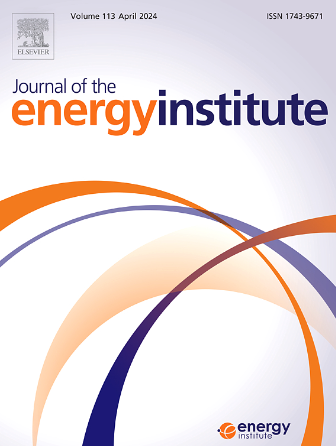甲烷与CO2和H2O混合重整:热力学分析和ReaxFF分子动力学模拟
IF 5.6
2区 工程技术
Q2 ENERGY & FUELS
引用次数: 0
摘要
在全球能源危机和碳中和目标的双重驱动下,高效利用富含碳的工业废气已成为推动可持续发展的重要战略途径。本文采用热力学平衡计算和ReaxFF模拟相结合的方法,系统研究了反应温度、压力和原料气组成对甲烷混合重整产物的影响。重点研究了CO2在甲烷蒸汽重整中的调节作用和H2O在甲烷干重整中的协同作用。结果表明:目标气体百分比随温度升高而升高,随CO2浓度和系统压力的升高而降低;碳沉积分析表明,碳的形成在高温下下降,特别是在1200 K以上,二氧化碳或水的引入显著抑制了碳的沉积。在蒸汽甲烷重整过程中,CO2的加入降低了H2/CO比,温度提高了H2/CO的利用率,压力抑制了H2/CO的利用率。在甲烷干重整过程中,水对H2/CO比的影响小于1200 K,只有在较高温度下才有活性,在高压下其利用率也会下降。只有在1200K以上,额外的水和二氧化碳才会变得有益。通过阐明反应途径和关键中间体的行为,本研究为甲烷混合重整过程中碳资源的有效转化提供了理论见解。为工业规模重整反应器的运行控制提供了科学依据。本文章由计算机程序翻译,如有差异,请以英文原文为准。
Mixed reforming of methane with CO2 and H2O: Thermodynamic analysis and ReaxFF Molecular dynamics simulation
Under the dual drivers of the global energy crisis and the carbon neutrality objective, the efficient utilization of carbon-rich industrial waste gas has emerged as a critical strategic approach to advancing sustainable development. In this paper, the effects of reaction temperature, pressure and raw gas composition on the products of methane mixed reforming were systematically studied by combining thermodynamic equilibrium calculations with ReaxFF simulation. Particular attention was given to the regulatory role of CO2 in steam methane reforming and the synergistic effect of H2O in dry reforming of methane. The results show that the percentage of target gas increases with temperature but decreases with increasing CO2 concentration and system pressure. Carbon deposition analysis indicates that carbon formation declines at elevated temperatures, particularly above 1200 K, where the introduction of CO2 or H2O significantly inhibits carbon deposition. In steam methane reforming, CO2 addition decreases the H2/CO ratio, with its utilization enhanced by temperature but suppressed by pressure. In dry reforming of methane, water has little effect on the H2/CO ratio below 1200 K, becoming active only at higher temperatures and its utilization similarly declines under elevated pressure. Only above 1200K does the addition of extra water and carbon dioxide become beneficial. By elucidating reaction pathways and the behavior of key intermediates, this study provides theoretical insights into the efficient conversion of carbon resources during methane-mixed reforming. It establishes a scientific basis for the operational control of industrial-scale reforming reactors.
求助全文
通过发布文献求助,成功后即可免费获取论文全文。
去求助
来源期刊

Journal of The Energy Institute
工程技术-能源与燃料
CiteScore
10.60
自引率
5.30%
发文量
166
审稿时长
16 days
期刊介绍:
The Journal of the Energy Institute provides peer reviewed coverage of original high quality research on energy, engineering and technology.The coverage is broad and the main areas of interest include:
Combustion engineering and associated technologies; process heating; power generation; engines and propulsion; emissions and environmental pollution control; clean coal technologies; carbon abatement technologies
Emissions and environmental pollution control; safety and hazards;
Clean coal technologies; carbon abatement technologies, including carbon capture and storage, CCS;
Petroleum engineering and fuel quality, including storage and transport
Alternative energy sources; biomass utilisation and biomass conversion technologies; energy from waste, incineration and recycling
Energy conversion, energy recovery and energy efficiency; space heating, fuel cells, heat pumps and cooling systems
Energy storage
The journal''s coverage reflects changes in energy technology that result from the transition to more efficient energy production and end use together with reduced carbon emission.
 求助内容:
求助内容: 应助结果提醒方式:
应助结果提醒方式:


